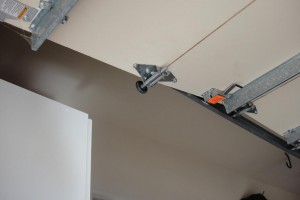by Nick Gromicko, Rob London and Kenton Shepard
Garage doors are large, spring-supported doors. Garage door openers control the opening and closing of garage doors, either through a wall-mounted switch or a radio transmitter. Due to the strain that garage door components and openers regularly endure, they may become defective over time and need to be fixed or replaced. Defective components may create safety hazards as well as functional deficiencies to the garage door assembly. The following

facts demonstrate the dangers posed by garage doors:
- Garage doors are typically among the heaviest moving objects in the home and are held under high tension.
- Injuries caused by garage doors account for approximately 20,000 emergency room visits annually, according to the U.S. Consumer Product Safety Commission.
- The majority of the injuries caused by garage doors are the result of pinched fingers, although severe injuries and deaths due to entrapment occur as well. Sixty children have been killed since 1982 as a result of garage doors that did not automatically reverse upon contact.
Inspectors cannot fix or adjust any garage door defects they may encounter. They should call out defects in their reports and recommend that the door be examined by a trained garage door technician. The following components should be present during inspections and devoid of defects:
- Manual (emergency) release handle. All garage doors should be equipped with this device, which will detach the door from the door opener when activated. It is vital during emergency situations, such as when a person becomes trapped beneath the door or when a power outage cuts electricity to the door opener. Inspectors should activate the handle to make sure that it works, although they will have to reset the handle if it does not reset automatically. In order for the handle to be accessible and obvious, it must be…
- colored red;
- easily distinguishable from rest of the garage opener system; and
- no more than 6 feet above the standing surface.
- Door panels. Both sides of the door should be examined for the following:
- fatigue;
- cracking and dents. Aluminum doors are especially vulnerable to denting; and
- separation of materials.
- Warning labels. The following four warning labels should be present on or around garage door assemblies:
- a spring warning label, attached to the spring assembly;
- a general warning label, attached to the back of the door panel;
- a warning label attached to the wall in the vicinity of the wall control button, and;
- a tension warning label, attached to garage door’s bottom bracket.
- Brackets and roller shafts.
- Brackets. The garage door opener is connected to the garage door by a bracket that is essential to the function of the door opener system. Placement of the bracket where it attaches to the door is crucial to the operation of its safety features. It should attach 3 to 6 inches from the top of the door. This bracket, as well as all other brackets, should be securely attached to their surfaces.
- Roller shafts. Roller shafts should be longer on the top and bottom rollers. The top rollers are the most important. Without longer shafts, if one side of the door hangs up, the door may fall out of the opening.
- Door operation. The door’s operation can be tested by raising the door manually, grasping the door’s handles if it has them. Inspectors can make sure that the door:
- moves freely;
- does not open or close too quickly; and
- opens and closes without difficulty.
Note – Inspectors should not operate the door until they have inspected the track mounts and bracing. Doors have been known to fall on people and cars when they were operated with tracks that were not securely attached and supported.
- Extension spring containment cables. Older garage doors may use extension springs to counter-balance the weight of the door. These require a containment cable inside the spring to prevent broken parts from being propelled around the garage if the spring snaps. Most new garages use shaft-mounted torsion springs that do not require containment cables.
- Wall-mounted switch. This device must be present and positioned as high as is practical above the standing surface (at least five feet as measured from the bottom of the switch) so that children do not gain access. In addition, the button must…
- be mounted in clear view of the garage door; and
- be mounted away from moving parts.
- Automatic reverse system. As of 1991, garage doors are required to be equipped with a mechanism that automatically reverses the door if it comes in contact with an object. It is important that the door reverses direction and opens completely, rather than merely halting. If a garage door fails this test, inspectors should note it in their reports. A dial on the garage door opener controls the amount of pressure required to trigger the door to reverse. This dial can be adjusted by a qualified garage door technician if necessary.Methods for testing the automatic reverse system:
- This safety feature can be tested by grasping the base of the garage door as it closes and applying upward resistance. Inspectors should use caution while performing this test because they may accidentally damage its components if the door does not reverse course.
- Some sources recommend placing a 2×4 piece of wood on the ground beneath the door, although there have been instances where this testing method has damaged the door or door opener components.
- Supplemental automatic reverse system. Garage doors manufactured in the U.S. after 1992 must be equipped with photoelectric sensors or a door edge sensor.
- Photoelectric eyes. These eyes (also known as photoelectric sensors) are located at the base of each side of the garage door and emit and detect beams of light. If this beam is broken, it will cause the door to immediately reverse direction and open. For safety reasons, photo sensors must be installed a maximum of 6 inches above the standing surface.
- Door edge sensors. This device is a pressure-sensitive strip installed at the base of the garage door. If it senses pressure from an object while the door is closing, it will cause the door to reverse. Door edge sensors are not as common in garage door systems as photoelectric eyes.
Safety Advice for Clients:
- Homeowners should not attempt to adjust or repair springs themselves. The springs are held under extremely high tension and can snap suddenly and forcefully, causing serious or fatal injury.
- No one should stand or walk beneath a garage door while it is in motion. Adults should set an example for children and teach them about garage door safety. Children should not be permitted to operate the garage door opener push button and should be warned against touching any of the door’s moving parts.
- Fingers and hands should be kept away from pulleys, hinges, springs, and the intersection points between door panels. Closing doors can very easily crush body parts that get between them.
- The automatic reversal system may need to be adjusted for cold temperatures, since the flexibility of the springs are affected by temperature. This adjustment can be made from a dial on the garage door opener, which should only be changed only by a trained garage door technician.
In summary, garage doors and their openers can be hazardous if certain components are missing or defective. Take all recommendations for repairs very seriously, particularly if you have children.
This article posted with permission from InterNACHI
Philippe Heller started The Real Estate Inspection Company in 2004 after a really poor home inspection on his own house. He applied his background in technology to build an innovative, industry-leading company. Working for SDG&E, GE Power Systems, Cox Communications and Time Warner Communications taught him a lot about technology, quality, and customer service. These traits are passed on to all of the employees in the company.
 facts demonstrate the dangers posed by garage doors:
facts demonstrate the dangers posed by garage doors:



